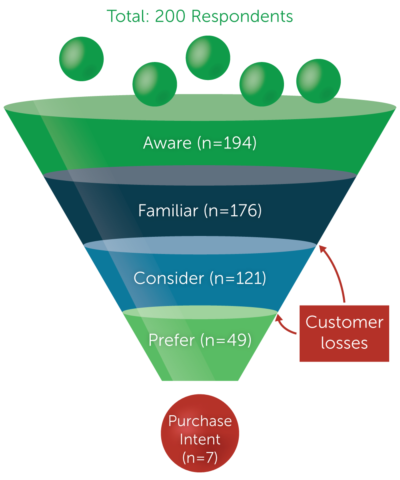Custom Research Case Study
Brand Health

The Client
ISR was approached by the Chief Marketing Officer at a Top 5 large, global CRO with the question ‘How do you create momentum in an already well-established brand?’ As the Chief Marketing Officer, our client was responsible for understanding and communicating to shareholders the current state of their brand.
The client felt as if their brand had hit a ceiling and was feeling a sense of stagnation in their marketing efforts. Wishing to ensure continued brand growth, our client needed to know which components of their brand were succeeding and which may be falling short. With this information, our client would be able to tell how these dynamics would manifest themselves in the larger organization’s successes and failures.
The Solution
A holistic approach to brand health, diagnosing where in the purchasing process the client was losing potential customers.
What is Brand Health?
Getting a potential customer to the RFP stage is not a single step process. ISR follows and measures health during five main steps in the purchasing process, also known as the purchase funnel. The performance of a company across the different steps in this funnel is what we refer to as the company’s Brand Health. Any company will lose potential customers at every stage in this funnel, but when large chunks of customers are falling out at certain stages disproportionately, that signals an issue with brand health.
The five steps are:
The Project
ISR took a diagnostic approach to the brand’s health to determine where and how the brand was succeeding and failing at each stage. While larger organizations tend to have more issues at later stages of the process, smaller organizations often struggle in earlier stages.
In order to get the right information in a perception study, it’s important to get those perceptions from the actual pool of potential customers. For this project that included project managers, medical directors, heads of therapeutic areas, and heads of outsourcing. These individuals typically hold most of the influence over purchasing decisions. As a large, global CRO, our client needed respondents located worldwide, with an emphasis in North America and Western Europe. They also needed respondents across a wide spectrum of company sizes, from large pharma to small & emerging biotechs. ISR provided 200 respondents fitting these qualifications.
The project began with a two-week, highly collaborative period of determining the client’s needs and ensuring proper targeting of respondents. The client was heavily involved at this point of the project, and then again during the questionnaire design process, ensuring the survey language accurately translated the CRO’s internal language into standard industry terminology. The next several weeks comprised the main phase of the project with less client involvement. These weeks were spent refining the questionnaire and collecting data. At this point the client again became more heavily involved, as the data collection period ended and the project moved to the analysis and reporting phases.
The Result
Identification of highly specific and actionable solutions that would address the organization’s brand health issues.

Final Phase
The final phase of the project consisted of working with the client to determine what portions of the purchase funnel were performing poorly, and focusing solutions on buyer behaviors that would deliver the desired improvements in brand health.
Our client discovered that there were highly specific instances at both the consideration and preference stages of the purchase funnel which were leading to large volumes of potential customers dropping out of the purchasing process. These customers held beliefs and attitudes about the range and fit of our client’s services, leading them to disregard the client at the consideration stage. Meanwhile, other potential customers who already were considering the client ended up preferring other vendors due to beliefs about the company’s historical performance in outsourced clinical development.
To counter these attitudes and beliefs, ISR worked with the client to develop educational content for its potential customers. Using this educational content, the client was able to expand its potential customer pool at each of these stages, translating into more customers reaching the RFP stage.

